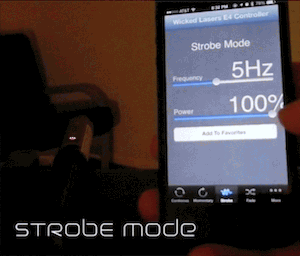Home
A comprehensive resource for safe and responsible laser use
World: Smartphone app can remotely control handheld laser
09 Oct 2013 -- Categories: Unusual lasers & uses | SLA news
Internet seller Wicked Lasers has introduced a $200 handheld laser whose beam power and on/off patterns can be remotely controlled by a smartphone app. The Evo is a green (532 nm) laser with a minimum of 100 milliwatts of output power (safety Class 3B) and a beam divergence of 1.5 milliradians. The stated Nominal Ocular Hazard Distance is 154 feet or 47 meters.
The company’s free “Evo” app is available on Apple iOS and Android app stores. A smartphone connects to the Evo laser either using a cable from the audio output jack, or wirelessly using an optional $40 Bluetooth module that attaches to the laser. Once connected, the app allows remote control of the laser’s output power, and of its flashing frequency. (Although anyone can download the app, the software does not appear to run unless connected to a Wicked E4 series laser such as the Evo.)
The software code is available as open source, so that hobbyists can create their own software to custom-control the Evo.
The company’s free “Evo” app is available on Apple iOS and Android app stores. A smartphone connects to the Evo laser either using a cable from the audio output jack, or wirelessly using an optional $40 Bluetooth module that attaches to the laser. Once connected, the app allows remote control of the laser’s output power, and of its flashing frequency. (Although anyone can download the app, the software does not appear to run unless connected to a Wicked E4 series laser such as the Evo.)
The software code is available as open source, so that hobbyists can create their own software to custom-control the Evo.

Operating modes include Continuous, Momentary, Strobe, Fade, Morse Code and Ambient (microphone audio level). Click for a YouTube video showing these modes in action.
The Evo is turned on using a patented SmartSwitch, which helps prevent unauthorized use such as by children. The SmartSwitch must be pressed in a certain pattern in order for the beam to be energized.
On the product website, Wicked Lasers guarantees “delivery to every country in the world or your money back.” They also guarantee “the Evo is 100% legal under U.S. federal law and federal safety requirements.” In addition to government-required safety information, the label on Wicked Lasers includes the notice “WARNING: DO NOT SHINE YOUR LASER AT AN AIRCRAFT. Shooting a laser at an aircraft is considered a felony in the U.S.” On the checkout page, the buyer must check a box stating “I understand that lasing aircraft is a felony.”
From Wicked Lasers via gadget blogs such as Gizmodo. Thanks to Charles Maricle at AixiZ for bringing this to our attention.
Note from LaserPointerSafety.com: From a safety standpoint, it does not appear that the remote control feature significantly alters the hazard potential of this laser. There would be an increased hazard if the laser was positioned so the operator could not see the entire beam path. In such a case, a person, vehicle or aircraft might be lased without the operator’s knowledge. However, such a poor setup is a reflection of the operator’s thoughtlessness and is not an inherent feature of a remotely-operated laser.
On the product website, Wicked Lasers guarantees “delivery to every country in the world or your money back.” They also guarantee “the Evo is 100% legal under U.S. federal law and federal safety requirements.” In addition to government-required safety information, the label on Wicked Lasers includes the notice “WARNING: DO NOT SHINE YOUR LASER AT AN AIRCRAFT. Shooting a laser at an aircraft is considered a felony in the U.S.” On the checkout page, the buyer must check a box stating “I understand that lasing aircraft is a felony.”
From Wicked Lasers via gadget blogs such as Gizmodo. Thanks to Charles Maricle at AixiZ for bringing this to our attention.
Note from LaserPointerSafety.com: From a safety standpoint, it does not appear that the remote control feature significantly alters the hazard potential of this laser. There would be an increased hazard if the laser was positioned so the operator could not see the entire beam path. In such a case, a person, vehicle or aircraft might be lased without the operator’s knowledge. However, such a poor setup is a reflection of the operator’s thoughtlessness and is not an inherent feature of a remotely-operated laser.